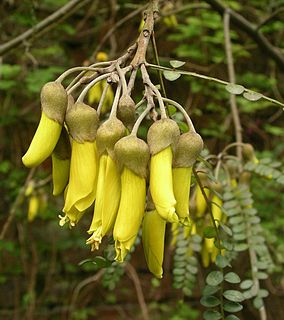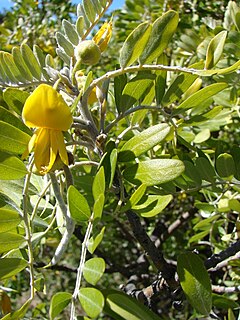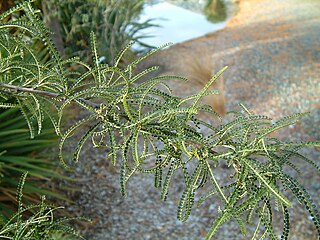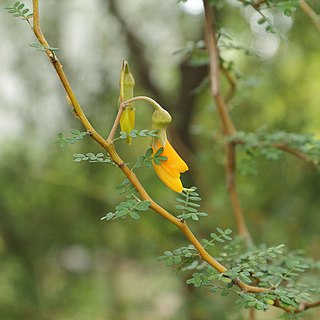
Kōwhai are small woody legume trees within the genus Sophora in the family Fabaceae that are native to New Zealand. There are eight species, with Sophora microphylla and S. tetraptera being the most recognised as large trees. Their natural habitat is beside streams and on the edges of forest, in lowland or mountain open areas. Kōwhai trees grow throughout the country and are a common feature in New Zealand gardens. Outside of New Zealand, kōwhai tend to be restricted to mild temperate maritime climates.

Sophora is a genus of about 45 species of small trees and shrubs in the pea family Fabaceae. The species are native to southern Asia, Australasia, various Pacific islands, western South America, the western United States, Florida and Puerto Rico. The generic name is derived from sophera, an Arabic name for a pea-flowered tree.

Dimethylallyl pyrophosphate is an isoprenoid precursor. It is a product of both the mevalonate pathway and the MEP pathway of isoprenoid precursor biosynthesis. It is an isomer of isopentenyl pyrophosphate (IPP) and exists in virtually all life forms. The enzyme isopentenyl pyrophosphate isomerase catalyzes isomerization between DMAPP and IPP.

Geranyl pyrophosphate (GPP), also known as geranyl diphosphate (GDP), is an intermediate in the isoprenoid biosynthesis pathway that produces longer prenyl chains such as farnesyl pyrophosphate and geranylgeranyl pyrophosphate as well as terpenes. GPP is a precursor to monoterpenes.

Sophora toromiro, commonly known as toromiro, is a species of flowering tree in the legume family, Fabaceae, that is endemic to Easter Island. Heavy deforestation had eliminated most of the island's forests by the first half of the 17th century, and the once common toromiro became rare and ultimately extinct in the wild in the 1960s.

Dermatophyllum secundiflorum is a species of flowering shrub or small tree in the family Fabaceae, that is native to the southwestern United States and Mexico. Common names include Texas mountain laurel, Texas mescalbean, frijolito, and frijolillo.

Sophora cassioides is a legume tree native to Chile.
In enzymology, an undecaprenyl-diphosphatase (EC 3.6.1.27) is an enzyme that catalyzes the chemical reaction

Styphnolobium japonicum, the Japanese pagoda tree is a species of tree in the subfamily Faboideae of the pea family Fabaceae.

Sophora flavescens, the shrubby sophora, is a species of plant in the genus Sophora of the family Fabaceae. This genus contains about 52 species, nineteen varieties, and seven forms that are widely distributed in Asia, Oceania, and the Pacific islands. About fifteen of these species have a long history of use in traditional Chinese medicines.

Sofalcone (INN) is an oral gastrointestinal medication used in Japan. It is a synthetic analog of sophoradin, a type of natural phenol found in Sophora tonkinensis, an herb used in traditional Chinese medicine.

Sophora tetraptera, commonly known as large-leaved kōwhai, grows naturally only in the central east of the North Island in New Zealand. S. tetraptera has larger more widely spaced leaves than the other seven species of kōwhai.
C55-isoprenyl pyrophosphate is an essential molecule involved in construction of the bacterial peptidoglycan cell wall. It is a receptor found in the plasma membrane of bacteria that allows glycan tetrapeptide monomers synthesized in the cell cytoplasm to translocate to the periplasmic space.

Matrine is an alkaloid found in plants from the genus Sophora. It has a variety of pharmacological effects, including anti-cancer effects, as well as κ-opioid and μ-opioid receptor agonism.
Sophora tonkinensis is a herb used in traditional Chinese medicine.

Sophora tomentosa, also known as necklacepod, yellow necklacepod, and occasionally as silver bush, is a pantropical shrub or small tree in the family Fabaceae. It commonly ranges in height from 4 to 10 feet and often occurs in coastal conditions and near wetlands. The common name Necklacepod is derived from the characteristic string of seed pods that develop after its yellow flowers germinate into seeds.

Sophora longicarinata is commonly known as kōwhai or limestone kōwhai that grows naturally in a limited range around northern Nelson and also western Marlborough in New Zealand. This species has quite small leaves compared to other similar species. Originally classified as a species in 1942 and then merged with Sophora microphylla it was reclassified as its own species again in 2001. As its common name suggests it grows in limestone areas. This species does not have a divaricating juvenile phase.

Sophora prostrata is commonly known as kōwhai, prostrate kōwhai or dwarf kōwhai and is endemic to the eastern South Island from Marlborough to the Waitaki Valley in New Zealand although most commonly found on the Banks Peninsula.

4′,7-Dihydroxyflavone is a flavone. It is found in Medicago truncatula in relation with the root nodulation symbiont Sinorhizobium meliloti or in seeds of Sophora viciifolia.

Sophora chathamica, the coastal kōwhai, sometimes known as Chatham Island kōwhai, is one of 8 species of native sophora or kōwhai in New Zealand and grows naturally in the north-west of the North Island in New Zealand, as far south as the Tongaporutu River in north Taranaki, and as far north as Te Paki. It can also be found growing near Wellington and the Chatham Islands, although these later plantings are thought to be a result of Māori plantings in the late 18th century and early 19th century. Prior to 2001, it was included as variant of Sophora microphylla, therefore references to either Sophora microphylla var. chathamica or Sophora microphylla subsp. microphylla var. chathamica are considered references to coastal kowhai.
















